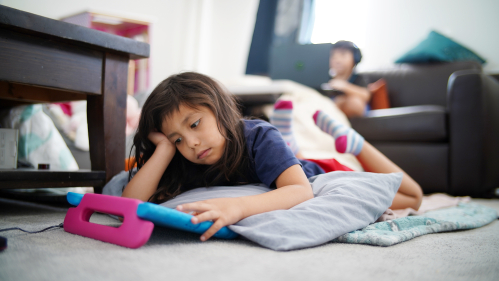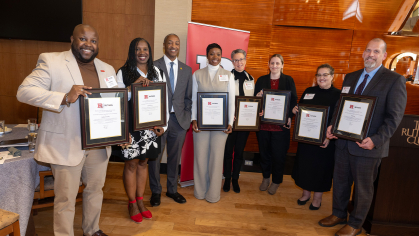The ABCDs of Remote Learning

Rutgers experts explain how digital inequality is widening our K-12 education gap during the pandemic
As school districts around New Jersey and the country revert from hybrid in-person to all-remote plans in response to COVID-19 outbreaks, many educators are concerned about our most vulnerable students who are more likely to have trouble with virtual learning because of digital inequality.
“Low-income students who don’t have access to summer camps and enrichment programs typically back-slide two to five months each summer,” said Vikki Katz, an associate professor with the School of Communication and Information (SC&I) at Rutgers-New Brunswick. “We just tacked on easily another six months to that, and we are looking at a whole school year ahead that almost certainly will be heavily disrupted.”
Katz says that after three months of emergency remote instruction this spring followed by two months of summer vacation, teachers are facing a potential avalanche of learning loss this September – especially among low-income students and those who are grappling with learning English.
“It’s all about the ABCDs of remote learning: Assistance, Broadband Connectivity and Devices,” said Katz, who conducts research with children growing up in low-income, working class and immigrant families and how they learn about and with new technology. “Students need all of those bases covered for distance learning to work.”
According to a July survey of 294,429 parents conducted by the New Jersey Department of Education, only 14 percent of parent respondents feel that remote learning has had a positive effect on their child’s education, said Rebecca B. Reynolds, an associate professor within SC&I who investigates human learning across a range of contexts including online participatory settings. Another 41 percent are just moderately confident and 45 percent are not confident of this at all, says Reynolds of the state survey results.
That’s likely because the entire educational infrastructure is built on the idea that students can visit a physical space to learn and gain access to resources, said Rutgers-Camden researcher Jim Brown, an associate professor of English and director of the Digital Studies Center. The pandemic, he said, has shed light on the fact that digital access is not evenly distributed and that publicly available systems – for instance, Wi-Fi at libraries – are resources that many people rely on.
“When students move to remote learning, those systems become difficult or impossible to access,” he said. “This means we need to figure out a way to make sure that everyone, no matter where they live, has high-speed internet access.”
In a grant-funded interview study of digital inequality measures among teachers and students that Reynolds is currently conducting, New Jersey teachers have reported that some families of students in their classes resorted to sitting outside the school in their cars to access the free school-based Wi-Fi because they did not have access at home.
“With more time to prepare, teachers and administrators may be able to remedy some (but certainly not all) of the digital inequality concerns experienced in spring 2020, moving into fall semester, if state and/or district funds are being leveraged to provide devices and home networking connectivity to those who lack these resources,” said Reynolds.
However, even if schools can provide laptops and hotspot access, that does not guarantee an adult will always be available and able to assist children using that technology.
“Those students may encounter other known barriers to access, such as digital literacy and prior experience with technology, motivation to engage with technology and ineffective design of learning resources,” said Reynolds.
This explains why Katz steers clear of using the term “digital divide” to characterize our growing digital inequality and the impact it’s had on our students’ education during the pandemic.
“Divide makes it sound like there are people who have everything they need and people on the other side who have nothing,” said Katz, who prefers to describe it as a digital continuum. “It’s more about how ‘under-connected’ families are than an either/or.”
For some students, especially in urban areas, just finding a dedicated space to learn at home presents challenges, but is not an impossibility, Carolyne White, a professor in Urban Education at Rutgers-Newark.
White, a social foundations scholar who has worked in urban settings to create culturally responsive teachers, says these challenges bring an opportunity to create a new context that effective learning can take place at home. In all-virtual urban districts, White suggests teachers reach out to parents to forge mutually empowering partnerships.
“One of the biggest problems we face is this myth that urban parents don’t care. That’s absolutely not true,” said White. “If a teacher is teaching on Zoom, are they willing to call parents and say ‘I want to be your partner’ and ask ‘What can you tell me about your child that will help me to be more effective?’”
What about those students who have access to the ABCDs of distance learning? Why did some experience success virtually learning this spring while others did not?
Reynolds said that’s because educators – with varying degrees of digital literacy – were tasked anew with emergency remote instruction with little time to research how to best design and implement online teaching and learning experiences. Some teachers also lacked their own child care, which placed significant time burdens on them.
It was a less than ideal combination, said Reynolds, who coedits Information and Learning Sciences, a journal that has published a special issue on remote teaching and learning strategies offering research-driven guidelines for educators.
The best solution to close education gaps being exacerbated by remote learning, Katz said, is rely on it as little as possible.
Katz, who lives in Manhattan and is hoping her own son will be able to start kindergarten in-person this year, supports those advocating using tents on streets and parking lots, as local restaurants have, in order to allow for open-air classrooms and employing recent college graduates having trouble finding work as aids to foster small group learning.
“None of this is perfect,” said Katz, “but we need to get kids back to meaningful and generative learning environments, not glorified child care or parking them somewhere so parents can go to work.”
White agrees that school districts rolling out all-remote or even hybrid plans should consider resources they haven’t before, including college students or recent graduates as online tutors to foster a sense of community many are missing.
“When I used to try to teach my daughter something, it was a disaster – she did not want to learn from me,” said White. “If we had college students available so that students could just talk and be listened to, it might be a totally different conversation.”
But don’t quit there, said Brown. Policymakers need to rethink public education from the ground up, he argues. That means not tying school funding to property taxes, but also undoing the decades-long defunding of K-12 public education that has exacerbated inequalities, digital and otherwise.
“If we want to address the inequalities that define our digital lives,” said Brown, “we have to address the deeper, systemic problems that continue to widen the gap between those who can assume systems will be available, accessible and working for them, and those who cannot.”


